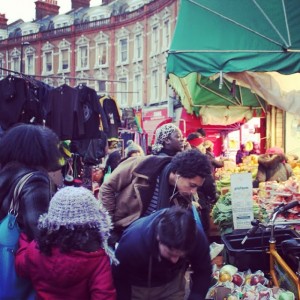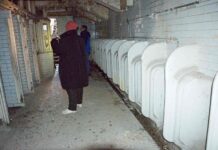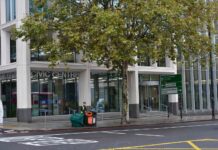A reader just sent in this description of Brixton in Nairn’s London from 1966. It’s a brilliant piece of writing about what Brixton was in the 1960s and, nearly fifty years on from when it was first published, it is also amazingly spot on about what Brixton is like today, as locals in 2015 battle against the ‘grand plans’ (aka ‘regeneration’) for the arches, Cressingham and other gentrifying projects . ‘With any luck’, says Nairn, the ‘Grand Plan’ ‘will be so grand that it is deferred until planners can understand what makes this place tick.’
‘Electric, all right, and high voltage too. A whole area east of Brixton Road, opposite the jolly town hall, where the ground floor has been dissolved and re-formed as a magic cave of people and goods. Stalls everywhere, arcades everywhere, diving through buildings and under the railway. Meat, fish, nylons, detergent: an endless, convoluted cornucopia. Compared with it, Petticoat Lane is synthetic; this cockney centre has kept all of its Victorian vitality. And it is the twentieth-century New World that has saved the bacon of the Old; for more than half the faces are one shade of brown or another. There is of course a Grand Plan out for this unplanned sky-rocketing power-house. With luck, it will be so grand that it is deferred until planners can understand what makes this place tick. It lives by free growth, like a great hedgerow tree. And as a tree depends on leaves, this vast emporium depends on the humble light bulb. Naked and without frills, binding the whole place into a web of stars at eye level. Electric.’
Ian Nairn, Nairn’s London, Penguin Books 1966, reissued 2014 p. 193-4





I have just drawn to my own attention, by checking my inbox, the fact that the Blog story that the Brixton pound was putting the face of Sir John Major on a £5 note was an April Fool story. A good one, well it fooled me. Pleased to know that the geniuses who run the brixton pound share the derisory view of this egregioius figure. As a retired person I now intend to put my whole pension pot into Brixton pounds.
The Grand Plan did exist and as Ian Nairn predicted died under the weight of its own concrete slabs. The evidence is still there in the prison-like Barrier Block (Southwyck House) on Coldharbour Lane. The grassed over wasteland in front of it is the clue: the block was designed to withstand the noise and pollution from a six-lane highway that would go on stilts right across Brixton on a flyover to Acre Lane. Just imagine the centre of Brixton a huge ugly concrete flyover. This was a GLC plan for a “motorway box” scything around inner London, but local politicians were hot for it. Notably a certain John Major, who was chair of Lambeth Housing Committee, the political architect of the barrier block (the actual architect committed suicide), the person who as much to wreck the fabric of Brixton as a dozen branches of Foxtons – beats me why the dreamers who run the Brixton pound have just put the visage of this ghastly bureaucrat on one of their notes. The council CPOed the whole block south of Coldharbour Lane, including the mansion blocks of Rushcroft Road, tthe best housing it accidentally owned, which through stupidity and incompetence it allowed to crumble and decay. The squatting community kept the area alive. The council spent millions trying to get them out, taking a case to the House of Lords to deny them tenure so it could sell the blocks to the developers now kitting them out for buy-to-let sharks to profit from. In other words, don’t just blame the gentrifiers, blame the council.